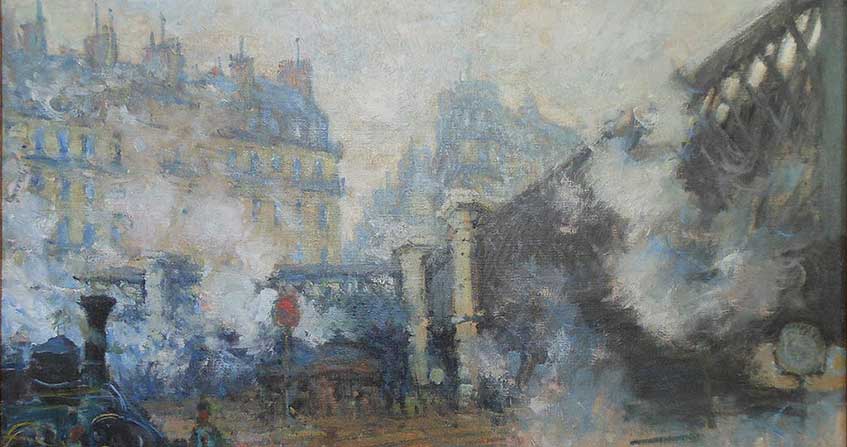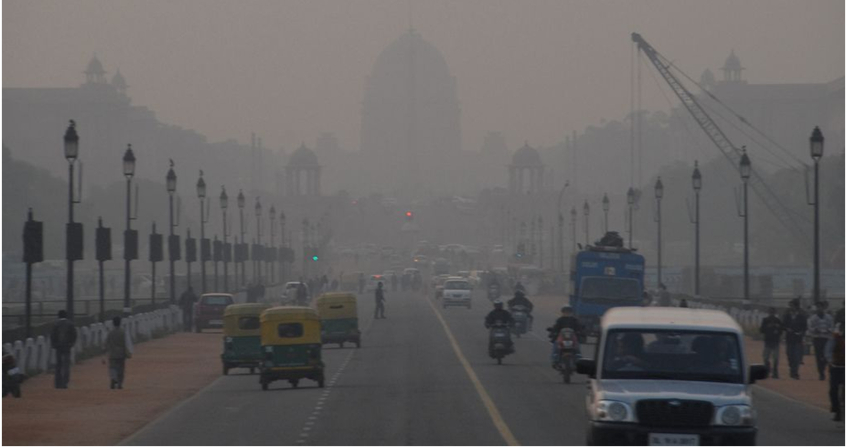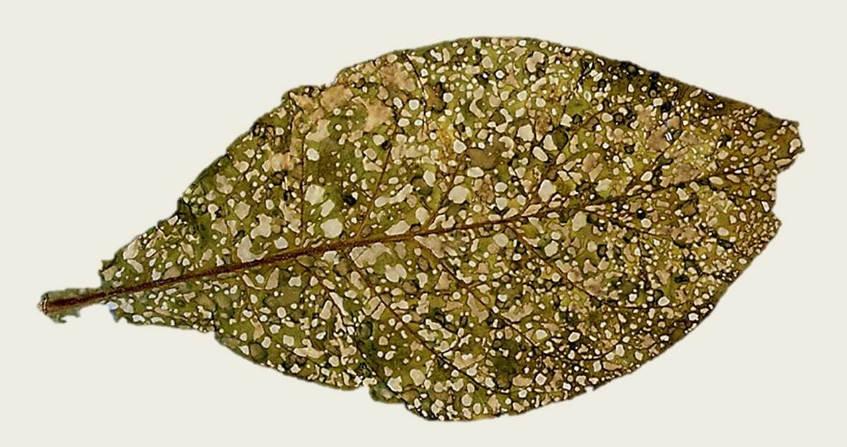How does the law protect air quality?
PDF
While the problem of air pollution is old (Focus #1), it is nevertheless very contemporary because of the awareness of its environmental and health impacts. In France, ambient air quality management is based on air quality standards monitored by a network of nearly 650 measuring stations. The various air quality standards are associated with devices that are either emergency procedures designed to quickly restore pollutant concentrations compatible with public health or police measures to reduce chronic pollution.
1. Why is it necessary to protect air quality?
“Air pollution is the introduction by man, directly or indirectly, or the presence in the atmosphere and confined spaces, of chemical, biological or physical agents with harmful consequences likely to endanger human health, harm biological resources and ecosystems, influence climate change, damage material property, cause excessive odour nuisance” [1].
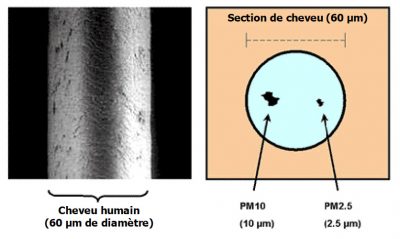
The regulation and monitoring of these pollutants is required by European Union law governing the matter (Focus #2).
1.1. Air pollution damages the environment
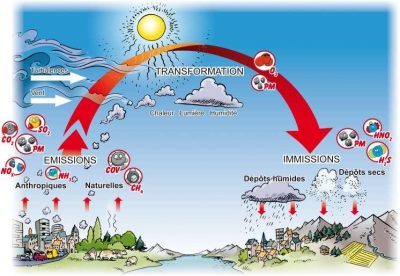
Nitrogen compounds also contribute to soil eutrophication. The main plant nutrient, nitrogen, received in excess by atmospheric deposition, generates a nutritional imbalance that is seriously damaging to sensitive ecosystems such as forests, marshes and grasslands (Figure 2).
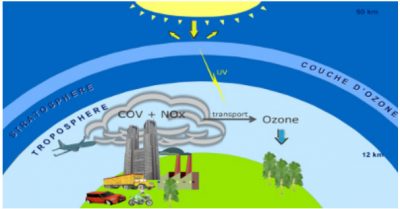
These different effects of air pollution are not only sensitive at the local level but also at the national, continental and even global level (Focus # 3). Pollutants cross state borders and move with the wind for hundreds or even thousands of kilometres. The specificity of the atmosphere appears here in full light. It is the most mobile element on the planet, by its very nature a transit medium for substances emitted into the air which, if they are to fall back to earth, will eventually contaminate the biosphere by polluting water and soil. The atmosphere thus has a capacity for self-purification; a number of substances disappear from it by leaching (precipitation) or dry deposition or are rapidly destroyed by various processes or reactions (photolytic dissociation, inactivation, chemical elimination).
1.2. Air pollution seriously affects health
While the health dimension certainly does not summarize the challenges of air pollution control, health has a clear priority. This is evidenced by the recognition of the right of everyone to breathe air that does not harm their health [3]. Similarly, the definition of air pollution includes biological agents, including pollens, which are perfectly natural elements that are considered pollutants only because of their allergenic effect on humans. Finally, air pollution applies to confined spaces (dwellings, means of transport, public buildings, etc.) from a strictly health point of view, also in this case linked to the presence of natural pollutants (radon, etc.) or not (carbon monoxide, aldehydes, etc.) that are potentially very dangerous for human health.
Health precedence is also due to the fact that air pollution causes the premature death of thousands and even millions of people worldwide [4], and an increase in the frequency of certain diseases (over-morbidity), including asthma.
In France, according to Santé Publique France (e. g. Institut national de veille sanitaire), the number of anticipated deaths attributable to air pollution is estimated at around 48,000 per year for fine particles alone [5]. The European Environment Agency has produced figures of this order of magnitude: 45,120 premature deaths for PM2.5; 8,230 for nitrogen dioxide; 1,780 for ozone [6].
In the long term, exposure to pollution levels commonly observed in urban and peri-urban environments appears to induce cancer and result in excess mortality and a decrease in life expectancy from several months to several years [7]. The International Agency for Research on Cancer (IARC) classified engine exhaust gases as Group 1 (“certain human carcinogen”) in June 2012 and then, in 2013, air pollution and particulate matter. In addition, certain types of hydrocarbons (benzene, polycyclic aromatic hydrocarbons, aldehydes, etc.), particles (such as those emitted by diesel engines) or persistent organic pollutants (dioxins, DDT, PCB, etc.) can cause, even in small doses, disorders of varying severity, ranging from respiratory or ocular discomfort to leukaemias and other cancers, including alterations in the nervous, hormonal or immune system and genetic heritage.
2. How is ambient air quality managed?
Air quality management (immission) is about environmental quality; it must be distinguished from emission control (whether automotive, industrial, agricultural, or other) even if the two aspects are obviously linked, as emission source regulation is necessary to achieve quality standards.
2.1. Air quality standards
These standards are set, after consulting the National Agency for Food, Environment and Occupational Safety (ANSES), “in accordance with those defined by the European Union and, where applicable, by the World Health Organisation. These standards are regularly reviewed to take into account the results of medical and epidemiological studies” [8].
Two categories of standards are intended for pollution episodes or peaks: the alert threshold and the information and recommendation threshold.
The alert threshold corresponds to a “level above which short-term exposure poses a risk to the health of the general population or environmental degradation, justifying emergency response” [9].
The alert threshold is the one whose exceeding can cause adverse health effects in the short term for anyone exposed to it, hence the emergency situation to which public authorities must react by means of measures imposed on their recipients (e. g. alternating traffic).
Alert thresholds have been set for sulphur dioxide (SO2), nitrogen oxides (NOx), ozone (O3) and suspended particulate matter with a particle size of less than 10 micrometers (PM10) (Figure 4), as other regulated pollutants cannot reach sufficient concentrations in ambient air to pose a short-term health risk.
The information and recommendation threshold corresponds to a level above which “short-term exposure poses a risk to human health of particularly sensitive groups in the population and which requires immediate and adequate information to be provided to these groups and recommendations for reducing certain emissions” [10].
Indeed, within the general population, there are more fragile categories, composed of vulnerable people (pregnant women, infants and young children, people over 65 years of age, people with cardiovascular diseases, heart or respiratory failure, asthmatics) and sensitive people, i.e. people whose symptoms appear or are amplified during peaks (e. g. diabetics, immunocompromised people, people with neurological diseases or those with heart, respiratory or infectious risks).
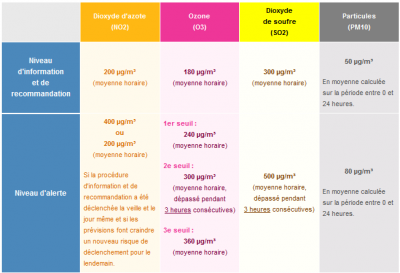
During the particulate pollution episode that affected the Île-de-France region in December 2016, which was the most intense of the last ten winters, PM10 concentrations were recorded at 259 µg/m3 (www.airparif.asso.fr/actualite/detail/id/187).
There are two categories of standards for chronic pollution: the limit value and the target value.
The limit value is “a level to be attained within a given period of time and not to be exceeded [11], and fixed on the basis of scientific knowledge in order to avoid, prevent or reduce harmful effects on human health or the environment as a whole” [12].
It represents the quality that the air must achieve over a given period (hour, day, year) that varies according to the pollutant considered. Values have been set for sulphur and nitrogen oxides, particulate matter (PM10 and PM2.5), lead, benzene and carbon monoxide.
The target value is “a level to be achieved, as far as possible, within a given time frame, and set in order to avoid, prevent or reduce harmful effects on human health or the environment as a whole” [13].

Target values have been set for ozone, some heavy metals (arsenic, cadmium, nickel), benzo(a)pyrene (polycyclic aromatic hydrocarbons tracer – volatile organic compounds) and until 2015 for PM2.5.
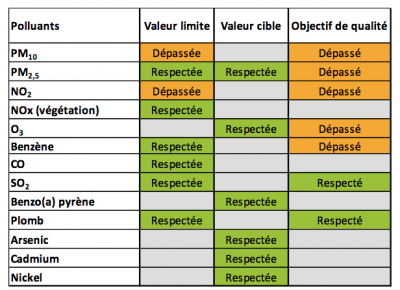
2.2. Who monitors air quality and how?
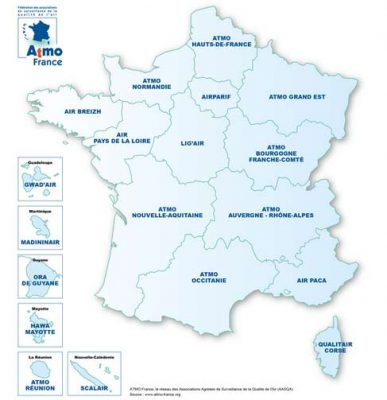
The AASQAs are in charge of various missions and in particular:
- monitoring of regulated pollutants (Figure 8, Figure 9);
- air quality prediction for pollutants that are subject to pollution event management procedures;
- informing the public, in particular through the air quality indices they calculate and disseminate (Figure 10, Figure 11);
- alert the police authority in the event of pollution peaks and disseminate information and recommendations throughout the pollution episode.
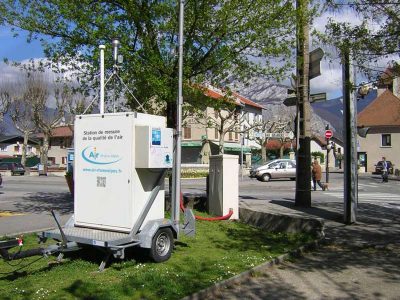
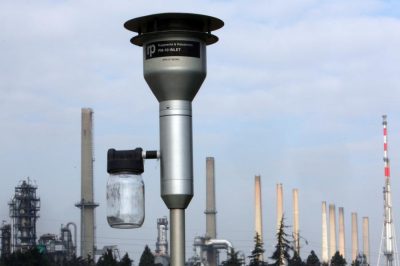
The calculation and dissemination of the ATMO index is mandatory in urban areas with more than 100,000 inhabitants. Calculated for a day, the ATMO index is an integer between 1 and 10 with an associated color code. The ATMO index is equal to the largest of the four sub-indexes calculated for sulphur dioxide, nitrogen dioxide, ozone and particulate matter (Figure 10).
The index is represented by a representation that is easily understood by all audiences (Figure 11).

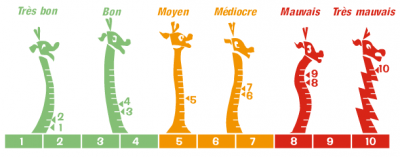
3. How is air quality actually protected?
3.1. The alerts
Exceeding the information and recommendation thresholds triggers public information actions as well as the dissemination of health recommendations and recommendations aimed at limiting emissions of the air pollutants concerned or their precursors (competence of the prefect in consultation with the Regional Health Agency – ARS, mayors, health establishments and medico-social establishments). Finally, recommendations aimed at reducing emissions are disseminated: carpooling, use of public transport, reduction of non-essential car travel by companies and administrations, adaptation of working hours, teleworking, use of car park relays, etc.
However, for PM10 and ozone, when an exceedance of the information and recommendation threshold is measured for two consecutive days or when an exceedance of the information and recommendation threshold is predicted for the same day and the next day by modelling (“persistent pollution episode”), the system automatically switches from an information-recommendation procedure, generating only optional measures, to an alert procedure, involving mandatory emergency measures.
The exceeding or risk of exceeding an alert threshold, modelled or observed by an OASQA or the existence of a persistent pollution episode (PM10 and ozone), triggers the emergency procedure.
The alert procedure requires the prefect to inform the population and take emergency measures to limit the extent and effects of the pollution peak on the population. These measures are specified by prefectoral or interpretative order. They must be adapted to the nature and extent of the pollution episode and to local conditions.
Information measures shall be disseminated under the same conditions as in the case of an information-recommendation procedure to sensitive or vulnerable persons and to the institutions most concerned (schools, crèches, hospitals and institutions for the elderly).
Regulatory measures include restrictions or even suspension of activities contributing to peak pollution, including, where appropriate, vehicle traffic.
These measures include at least the actions listed in the annex to a ministerial order [16], for each major emitting sector: agriculture (prohibition of nitrogen spraying, skimming or open burning…), industry (postponement of certain emitting operations, use of low sulphur fuels….), residential (postponement of maintenance or cleaning work with non-electric tools or products based on organic solvents, suspension of the use of inefficient biomass combustion appliances or generators), transport (automobile, air…) [17]. The restriction measures are thus aimed at a wide range of issuers. However, it is undeniably those applicable to motor traffic that are the most widely publicised, probably because they are aimed at the widest possible audience.
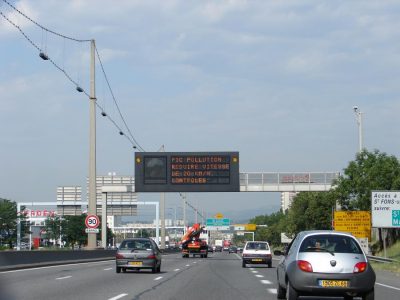
The alternating traffic is based on the number of the vehicle registration plate. The Conseil d’Etat, considering that the criterion of the mineralogical number is “easily applicable to users and controllable by the agents in charge of control“, considered that the alternate circulation system “is of general interest and makes it possible to react as soon as possible to pollution peaks according to an objective criterion” [18]. While the mineralogical number criterion is not arbitrary, it nevertheless lacks environmental justification.
Differentiated traffic is based on the level of pollutant emissions from vehicles. A nomenclature of vehicles classified according to their pollutant emission level was adopted in June 2016 [19] which was used for the implementation of the Air Quality Certificates (AQA) known as the Air Criteria.
There are 6 colour-coded classes, depending on the engine (petrol, diesel, gas, plug-in hybrid), the type of vehicle (two-wheel, three-wheel and four-wheel vehicles; passenger cars; light commercial vehicles; heavy goods vehicles, buses and coaches) and the date of first registration (or the Euro Standard). A specific class is reserved for “zero engine emission” vehicles (100% electric and hydrogen) in each category for which the AQA is green. The most polluting (oldest) vehicles in each category are not classified.
Drivers who contravene traffic restriction measures are liable to a fine of €22 to €35 and to immobilisation of their vehicle.
3.2. The Atmospheric Protection Plan
An atmospheric protection plan (PPA) must be drawn up (by the prefect) in all urban areas with more than 250,000 inhabitants. In addition, a PPP must be drawn up in areas where there is evidence or a risk of exceeding the limit values or target values. In the latter case, the PPP must be prepared within 18 months of the occurrence of the exceedance [20].
The use of PPP can be avoided if measures taken in another framework reduce concentration levels more effectively. The prefect must then prepare and make available to the public a simplified information document specifying in particular the measures taken and their expected effect, and ensure their annual follow-up.
The main objective of the PPP is to achieve compliance with the limit and target values. To this end, it lists the preventive and corrective measures, temporary or permanent, that may be taken by the competent police authorities within a perimeter delimited by the plan, such as stricter emission standards for certain categories of issuers or the permanent reduction of maximum authorised speeds [21].
3.3. Restricted traffic areas
The Energy Transition for Green Growth Act established “Restricted Traffic Areas” (RTAs) to “combat air pollution” [22].
Restricted areas can only be created in agglomerations and areas covered by a PPP. The decree creating the ZCR specifies the categories of vehicles concerned and sets out the traffic restriction measures applicable according to their classification (materialised by the colour of the Crit’air sticker). Access to the area may not be prohibited to certain vehicles whatever their classification (in particular police, gendarmerie, customs, fire, doctors, etc.). In addition, derogations may be granted, at the reasoned request of the persons concerned, by the traffic police authority.
In Paris, the circulation of heavy goods vehicles and coaches registered before 1 October 2001 (not meeting the criteria for obtaining the Crit’Air sticker) has been banned since 1 September 2015 every day from 8 am to 8 pm, including weekends. Unclassified vehicles (passenger cars and light-duty diesel or petrol vehicles put into service before 1 January 1997 and two-wheelers) may no longer operate on working days from 8 a.m. to 8 p.m. [23].
A driver who contravenes the restrictions of a ZCR is liable to a fine of €90 for a heavy vehicle and €45 for a passenger car, light truck or two- or three-wheel motor vehicle. The same fines shall be imposed for parking within the perimeter of the zone for the same vehicles when the vehicle is not identified or when access to the ZCR by the vehicle is prohibited at all times without interruption. These offences may also result in the immobilization of the vehicle [24].
4. How to find out about air quality?
The AASQAs constitute a major relay of information since they are loaded by the texts [25]:
- inform the public on a daily basis about air quality (observed and predictable);
- to relay information and recommendations during pollution episodes;
- to distribute freely and freely on their websites:
- annual descriptive maps of exceedance situations for ozone, nitrogen dioxide and particulate matter (PM2.5 and PM10);
- the annual regional review of air quality monitoring results;
- the spatialized regional inventory of primary emissions of regulated air pollutants and their precursors;
- the results of the monitoring of regulated pollutants and their updated forecasts ;
- air quality indices (Figure 13, Figure 14, Figure 15).
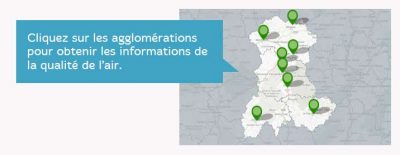
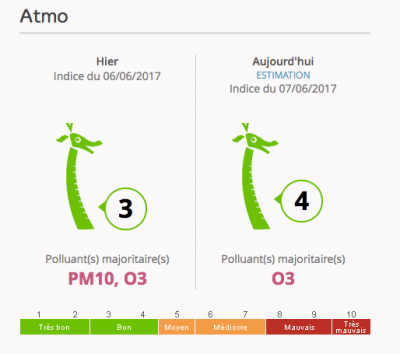
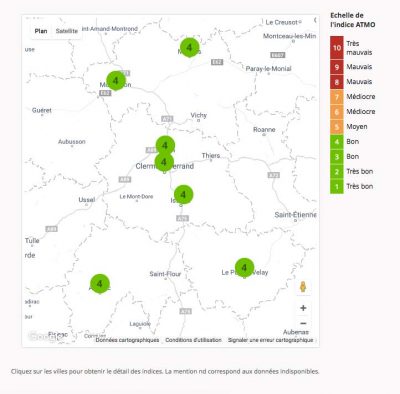
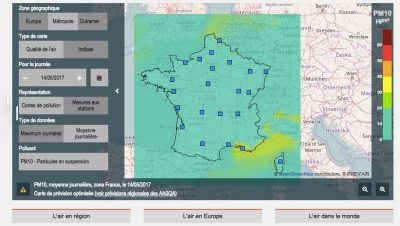
- maps predicting concentrations of particulate matter (PM10 and PM2.5), ozone and nitrogen dioxide for the same day, the next day and the next day;
- modelling maps of the concentrations of these same pollutants for the monitoring, integrating data from AASQA observations;
- links to the AASQA website to access the data produced by them and their regional forecasts.
Information on air quality is undoubtedly one of the most developed in the whole field of environmental law, probably commensurate with the concerns raised by air pollution and the responsibility of everyone in this field. Awareness is not the least virtue of this information, because if everyone is polluted, everyone is also a polluter. Without this awareness, the law will remain powerless to curb the phenomenon.
References and notes
Cover image. Public domain.
[1] Environmental Code, Article L. 220-2.
[2] Environmental Code, Article R. 221-1.
[3] Environmental Code, Article L. 220-1.
[4] According to the OECD, outdoor air pollution is estimated to cause 3 million premature deaths worldwide in 2010. Urban air pollution is even expected to become the leading cause of death in the world by 2050. This figure is projected to reach 6-9 million by 2060 (depending on whether a linear or non-linear concentration-response function is used) (OECD (2016). The economic consequences of outdoor air pollution, OECD, Paris).
[5] Public health France. (2016). Health impacts of air pollution in France: new data and perspectives: http://www.santepubliquefrance.fr/content/download/1003/9952/version/2/file/CP_pollution_atmospherique_210616.pdf
[6] European Environment Agency, Air quality in Europe, 2016, p. 60: https://www.eea.europa.eu/publications/air-quality-in-europe-2016/at_download/file.
[7] See https://www.airparif.asso.fr/pollution/effets-de-la-pollution-generalites.
[8] Environmental Code, Article L. 221-1.
[9] Environmental Code, Article R. 221-1, I, 11°.
[10] Environmental Code, Article R. 221-1, I, 10°.
[11] In any case, not to exceed more than the number of times authorized by the texts. Thus, the limit value for PM10 of 50 µg/m³ as a daily average should not be exceeded more than 35 times per calendar year.
[12] Environmental Code, Article R. 221-1, I, 7°.
[13] Environmental Code, Article R. 221-1, I, 6°.
[14] Directive 2008/50/EC of the Council and the European Parliament of 21 May 2008 on ambient air quality and cleaner air for Europe, Art. 16 (Official Journal of the European Union No L 152 of 11 June 2008, p. 1).
[15] Environmental Code, Article R. 221-1, I, 5°.
[16] Order of 7 April 2016 on the initiation of prefectoral procedures in the event of episodes of ambient air pollution (Official Journal of 9 April 2016, text No. 5), amended by Order of 26 August 2016 (Official Journal of 27 August 2016, text No. 1).
[17] See: The right actions on the website of the Ministry of Ecological and Solidarity Transition: http://www.ecologique-solidaire.gouv.fr/sites/default/files/Panneau%20les%20épisodes%20de%20pollution.pdf.
[18] EC 28 February 2000, Mr Petit-Perrin, req. No 189082.
[19] Order of 21 June 2016 establishing the nomenclature of vehicles classified according to their emission level of atmospheric pollutants pursuant to Article R. 318-2 of the Highway Code (Official Journal of 23 June 2016, text No 12).
[20] Environmental Code, Articles L. 222-4 and R. 222-20-1.
[21] Environmental Code, Article L. 222-6.
[22] General Code of Local Authorities, Article L. 2213-4-1.
[23] https://www.prefecturedepolice.interieur.gouv.fr/Nous-connaitre/Actualites/Prevention/Circuler-a-Paris-et-dans-l-agglomeration-a-compter-du-16-janvier-2017.
[24] Highway Traffic Act, Article R. 411-19-1.
[25] Environment Code, Article L. 221-1 and Decree of 19 April 2017 on the national ambient air quality monitoring system (Official Journal of 22 April 2017).
[26] The PREV’AIR consortium is composed of the Institut national de l’environnement industriel et des risques (INERIS), Météo-France, the Laboratoire central de surveillance de la qualité de la air (LCSQA) and the CNRS.
The Encyclopedia of the Environment by the Association des Encyclopédies de l'Environnement et de l'Énergie (www.a3e.fr), contractually linked to the University of Grenoble Alpes and Grenoble INP, and sponsored by the French Academy of Sciences.
To cite this article: MOLINER-DUBOST Marianne (January 15, 2021), How does the law protect air quality?, Encyclopedia of the Environment, Accessed April 29, 2024 [online ISSN 2555-0950] url : https://www.encyclopedie-environnement.org/en/society/how-law-protect-air-quality/.
The articles in the Encyclopedia of the Environment are made available under the terms of the Creative Commons BY-NC-SA license, which authorizes reproduction subject to: citing the source, not making commercial use of them, sharing identical initial conditions, reproducing at each reuse or distribution the mention of this Creative Commons BY-NC-SA license.





